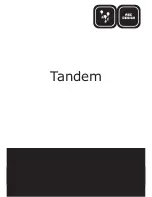
CHAPTER 5: SETTINGS
SYSTEM SETUP
L90 LINE CURRENT DIFFERENTIAL SYSTEM – INSTRUCTION MANUAL
5-145
5
X
react_n
=
the total neutral reactor inductive reactance. If identical reactors are installed at both line ends, the value of the
inductive reactance is divided by 2 (or 3 for a three-terminal line) before use in the previous equations. If the reactors
installed at both ends of the line are different, the following equations apply:
For two terminal line
:
Eq. 5-12
For three terminal line
:
Eq. 5-13
ZERO-SEQUENCE CURRENT REMOVAL
— This setting facilitates application of the L90 to transmission lines with one or more
tapped transformers without current measurement at the taps. If the tapped transformer is connected in a grounded wye
on the line side, it becomes a source of the zero-sequence current for external ground faults. As the transformer current is
not measured by the L90 protection system, the zero-sequence current creates a spurious differential signal and can
cause a false trip.
If enabled, this setting forces the L90 to remove zero-sequence current from the phase currents prior to forming their
differential signals, ensuring protection stability on external ground faults. However, zero-sequence current removal can
cause all three phases to trip for internal ground faults. Consequently, a phase selective operation of the L90 is not
retained if the setting is enabled. This does not impose any limitation, as single-pole tripping is not recommended for lines
with tapped transformers. See the Application of Settings chapter for guidelines.
LOCAL (TERMINAL 1 and TERMINAL 2) ID NUMBER
— In installations using multiplexers or modems for communication, it is
desirable to ensure the data used by the relays protecting a given line comes from the correct relays. The L90 performs this
check by reading the ID number contained in the messages sent by transmitting relays and comparing this ID to the
programmed correct ID numbers by the receiving relays. This check is used to block the differential element of a relay, if
the channel is inadvertently set to loopback mode, by recognizing its own ID on a received channel. If an incorrect ID is
found on a either channel during normal operation, the FlexLogic operand
87 CH1(2) ID FAIL
is set, driving the event with the
same name. The result of channel identification is also available in
ACTUAL VALUES
STATUS
CHANNEL TESTS
VALIDITY OF CHANNEL CONFIGURATION
for commissioning purposes. The default value “0” as the local relay ID setting
indicates that the channel ID number is not to be checked. See the Current Differential section in this chapter for additional
information.
For two-terminal applications, use the
LOCAL ID NUMBER
and
TERMINAL 1 ID NUMBER
. For three-terminal applications, also
use the
TERMINAL 2 ID NUMBER
.
CHNL ASYM COMP
— This setting enables/disables channel asymmetry compensation. The compensation is based on
absolute time referencing provided by GPS-based clocks via the Precision Time Protocol or IRIG-B. Use this feature on
multiplexed channels where channel asymmetry can be expected and which otherwise causes errors in current
differential calculations. The feature takes effect when all terminals are provided with reliable GPS clock signals. If the GPS
clock signal is lost at any terminal of the current differential protection system, or the real time clock not configured, then
the compensation is not calculated. If the compensation is in place prior to losing the GPS time reference, the last
(memorized) correction is applied as long as the value of
CHNL ASYM COMP
is “On.” See the Application of Settings chapter
for information.
The GPS-based compensation for channel asymmetry can take three different effects:
Charging current compensation calculations need to be performed for an arrangement where the VTs are
connected to the line side of the circuit. Otherwise, opening the breaker at one end of the line causes a calculation
error.
Differential current is significantly decreased when
CHARGING CURRENT COMPENSATION
is “Enabled” and the proper
reactance values are entered. The effect of charging current compensation is viewed in the
METERING
87L
DIFFERENTIAL CURRENT
actual values menu. This effect is very dependent on CT and VT accuracy.
Содержание L90
Страница 14: ...1 4 L90 LINE CURRENT DIFFERENTIAL SYSTEM INSTRUCTION MANUAL FOR FURTHER ASSISTANCE CHAPTER 1 INTRODUCTION 1 ...
Страница 68: ...2 54 L90 LINE CURRENT DIFFERENTIAL SYSTEM INSTRUCTION MANUAL SPECIFICATIONS CHAPTER 2 PRODUCT DESCRIPTION 2 ...
Страница 136: ...3 68 L90 LINE CURRENT DIFFERENTIAL SYSTEM INSTRUCTION MANUAL CONNECT TO D400 GATEWAY CHAPTER 3 INSTALLATION 3 ...
Страница 224: ...4 88 L90 LINE CURRENT DIFFERENTIAL SYSTEM INSTRUCTION MANUAL FLEXLOGIC DESIGN USING ENGINEER CHAPTER 4 INTERFACES 4 ...
Страница 692: ...6 36 L90 LINE CURRENT DIFFERENTIAL SYSTEM INSTRUCTION MANUAL PRODUCT INFORMATION CHAPTER 6 ACTUAL VALUES 6 ...
Страница 708: ...7 16 L90 LINE CURRENT DIFFERENTIAL SYSTEM INSTRUCTION MANUAL TARGETS MENU CHAPTER 7 COMMANDS AND TARGETS 7 ...
Страница 742: ...9 6 L90 LINE CURRENT DIFFERENTIAL SYSTEM INSTRUCTION MANUAL TESTING CHAPTER 9 COMMISSIONING 9 ...
Страница 804: ...10 62 L90 LINE CURRENT DIFFERENTIAL SYSTEM INSTRUCTION MANUAL FAULT LOCATOR CHAPTER 10 THEORY OF OPERATION 10 ...
Страница 872: ...C 6 L90 LINE CURRENT DIFFERENTIAL SYSTEM INSTRUCTION MANUAL COMMAND LINE INTERFACE APPENDIX C COMMAND LINE INTERFACE C ...
Страница 878: ...D 6 L90 LINE CURRENT DIFFERENTIAL SYSTEM INSTRUCTION MANUAL REVISION HISTORY APPENDIX D MISCELLANEOUS D ...
Страница 882: ...iv L90 LINE CURRENT DIFFERENTIAL SYSTEM INSTRUCTION MANUAL ABBREVIATIONS ...
Страница 900: ...xviii L90 LINE CURRENT DIFFERENTIAL SYSTEM INSTRUCTION MANUAL INDEX ...
















































